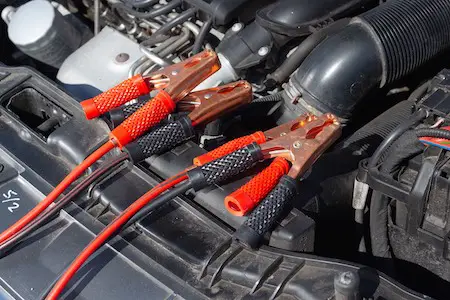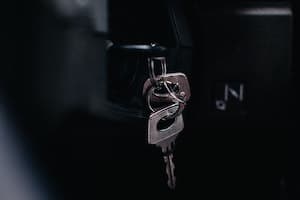When connecting and disconnecting a car battery, a small amount of sparking can occur and can be startling. I’ll explain why they spark and if it is a bad thing. Car batteries can be a nervous thing to work on and around and they should inspire you to take care. Car batteries can be dangerous and we should be educate ourselves enough to work around them safely.
Should a Car Battery Spark When Being Connected?
It is normal for a car battery to spark slightly when it is connected. Modern cars have electrical accessories that are always on and when you connect the battery cable to the battery terminal with things on, there will be a spark. A large spark when connecting the battery is not normal and may indicate a short in one of the circuits in the car.

When installing a battery, if there are electrical components that are “on” when the battery is connected, they will immediately begin to draw power. This immediate power draw is what causes a spark when the battery is connected.
Some say that you must connect one battery terminal before the other but this simply is not true. There is no increased risk of spark by connecting one battery terminal before the other. The best way to avoid battery spark is to ensure the car is not going to draw current immediately.
Avoid Car Battery Sparks
Your car battery should never produce large sparks when being connected or disconnected. If it does spark or if any melting of the terminal or cable occurs, immediately disconnect the battery.
Why Does My Car Battery Spark?
A spark will occur because the electricity will arc between the terminal and the cable JUST before you touch them together. This happens when there is a potential difference between the two contact points. So if the car has something that is requiring energy before the battery is connected, it creates a larger potential difference, hence the spark.
Modern cars have a lot of electrical components and any power supply in the electronics will have capacitors that have discharged while disconnected. When you reconnect the battery to the car, those capacitors in the circuit will charge quickly drawing a small amount of current from the battery and cause a spark at the point of contact (The battery terminal).
This is why slight sparking at the battery terminal is normal.
Connecting the first cable does not cause a spark since there is no return path for the current. With the second cable connected, a return path for the electricity is created, and it produces sparks – no matter which cable is connected first or last!
Large sparking is not normal.
If a battery terminal creates a large spark when connecting the cable, or begins to melt the metal terminal then there is a short circuit somewhere in the electrical system and the car should be taken to a professional to be diagnosed. If you are curious about how to diagnose and fix a parasitic battery drain issue yourself, read this very well written guide of how to resolve the issue yourself at the Shop Tool Reviews website.
Basically, you remove each fuse in the car, then check if there is still a short in the system and continue to do so until you narrow the short circuit to one of the fuses in the car.
The Best Way to Reduce Car Battery Sparks
Ensure all electronics in the car are turned off to avoid sparking when installing a car battery. Things like if your car door is open, and the dome light is on will increase current draw from the battery causing sparks. If the battery continues to spark it is caused by a short in the electrical system.
Some cars have a clock that will draw power, some hoods have lights so with the hood open you have that light that will draw electricity. If you have a remote start system or automatic doors, some actively search for signals and require a bit of power. Or even things like your phone being plugged in to the charger or anti-theft system.
By reducing the number of things on or plugged in, you can reduce the spark at the battery.
A battery may continue to spark with all things off because of the capacitors in the electrical systems in modern cars that must recharge and will draw current, but if there continues to be a large spark, there is a short in the system.
Which Battery Terminal to Connect First- Positive or Negative?
The important factors to consider are circumstances such as if the car is being jump started? And what is the best way to reduce the chance of forming a contact between the two battery terminals?
Regular Battery Install – Connecting Terminals
The order battery terminals are connected is not important when installing a car battery. What IS important is that nothing conductive touch both battery terminals simultaneously. When jump-starting a car you should connect the cables at the same time, but if you were to do them separately connect the positive cable first.
Connecting the positive and negative battery terminals together will result in arcing and big sparks and can cause serious injury by shocking you. If left for a prolonged period of time, the car battery can explode.
Connecting the positive cable first and removing it last when installing a car battery does not reduce the spark because spark is caused by the potential difference at the connection. No matter the order, the voltage potential is the same, hence the chance of spark is the same.
Connecting the positive terminal first, may reduce the chance that you make a connection between the positive terminal and the chassis after the negative is connected to the chassis, but you should always take care and use the right tools and will have no issues.
Using an insulated wrench is highly recommended when connecting or disconnecting the battery terminals in your car. The reason these are used is by having an insulated handle, if you ever unintentionally create a bridge between the two terminals, the battery will arc, and produce a lot of heat. Use the right tool. Take a look at this inexpensive but safe and very convenient insulated ratcheting terminal wrench on Amazon.
If the spark is big you may have other problems. The spark should be small and not melt the metal much. If you smell burning plastic forget what I wrote and unhook the wire quickly. Call in a mechanic.
Jump-Starting Battery Connection
The order you connect the battery terminals when installing a battery does not make a difference as long as nothing creates a connection between the terminals. The safest way to jumpstart a car is to connect both the positive and negative cables at the same time.
The reason that connecting the positive terminal first may be safer when jump-starting a car is given that the first battery is connected already, by connecting the negative terminal first, you risk shorting out the first battery by touching the positive terminal to anywhere on the body of the second car.
Pro Tip: Always look for the symbol (+) and (-) on the battery terminals when connecting them. Do not rely on the cables simply by their color.
Why Should I Connect the Positive Battery Terminal First?
When jumpstarting a car it is important to connect the battery terminals in a way that does not allow for a connection to be made between battery terminals. Once the first car is connected to the jumper cables, the positive battery terminal should be attached first to reduce the risk of touching both terminals to the chassis.
The positive cable is recommended by many to be attached first when jump-starting a car because once the first battery is connected, if you had the negative attached first, touching the positive jumper cable to ANY part of the frame or ground would cause a short. By connecting the positive cable first, you reduce the risk of a short happening.
Other than for the increased risk of touching both cables to the frame of the car, there is no reason that you need to connect the positive terminal first. The safest way to connect battery terminals when jump-starting a car is to connect them simultaneously because this ensures they never have the chance to touch each other.
What Happens When I Connect the Negative Battery Terminal First Installing a Battery?
The order does not matter in which you attach the cables to the battery. When you connect the negative terminal first, you create a problem if after that, form a connection between the positive terminal and the chassis which would cause a short and could cause you harm.
You should always be aware with a wrench or any other tool never to touch both battery terminals or the positive terminal to the frame of the car so the order really doesn’t matter since you will be aware of the battery terminals.


